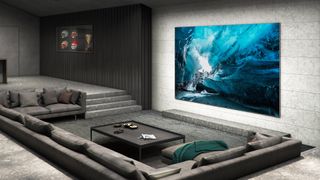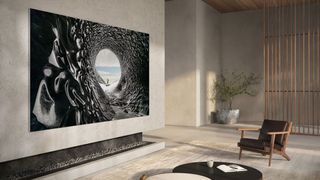Micro LED TV: the premium display tech explained
Will Micro LED take the crowning spot for premium TV technologies?

How many times can a brand say it’s launching a new TV technology before actually doing so? Samsung first unveiled ‘The Wall’ Micro LED television in Las Vegas at the CES tech event in 2018, while Sony has been promising Micro LED tech in its TVs for some time now.
2021 could be the year Micro LED comes to our homes – or at least some homes with the right amount of space and the big budgets to match. At the Unbox & Discover March 2021 event, Samsung announced that Micro LED televisions will be launching in their largest 110-inch and 99-inch sizes "globally beginning at the end of March", with an 88-inch size coming in late 2021. Those large versions of The Wall are available to companies and via custom installers.
Samsung also announced a step-down 76-inch size. It might still be in big-screen territory, but this is the smallest for the Micro LED tech, which is famously difficult to condense to smaller sizes. And Samsung might be backing away from those sizes, according to fresh reports.
Does this mean Micro LED is becoming more and more viable every day? Below we outline all the things that make Micro LED such a compelling idea, and why your next TV might well be packing Micro LED technology.
What is Micro LED?
Micro LED is a method of getting brighter, higher-contrast images from a TV than is otherwise currently possible.
What are Micro LED's advantages?
Increased brightness, long life-span, and a low power-consumption are among the many advantages manufacturers tout for the new Micro LED panel format.
Are Micro LED TVs expensive?
Expensive? A new TV? Right now, the answer is: yes, and ruinously so. But that has been true of the infancy of every new TV technology...
Will I be able to see the difference with Micro LED?
Most certainly. Even when screens get down to manageable sizes, the contrast ratio and brightness of a typical Micro LED TV is obvious.

What is Micro LED?
At the moment, LEDs are used to deliver backlighting to LCD screens – every current TV that isn’t an OLED uses this methodology of shining light through its pixels. And every TV that isn’t an OLED uses one LED to backlight dozens, maybe hundreds, of pixels at a time.
But Micro LED uses LEDs so small that they are able to function as individual pixels. And a pixel that is its own light-source doesn’t require any backlighting. This means screens are slimmer (due to the lack of backlighting) and images are better controlled across the board. Greater color fidelity, wider contrasts and increased brightness are suddenly all available.
Of course, self-emitting pixels are exactly what makes OLED TVs so compelling. But Micro LED doesn’t use any organic components, so the inevitable deterioration of performance that afflicts OLED screens won’t become an issue for Micro LED for hundreds of thousands of hours of use. Neither is the rare-but-dreaded ‘screen burn’ an issue with Micro LED.
Get daily insight, inspiration and deals in your inbox
Get the hottest deals available in your inbox plus news, reviews, opinion, analysis and more from the TechRadar team.
And Micro LED has the potential to deliver far, far brighter images than OLED – and with HDR picture technology becoming ubiquitous, that’s a big advantage. The brightest OLED TVs peak at around 1,000 nits – but Samsung has already achieved 4,000 nits from its Micro LED screens, and is confident that 10,000 nits is achievable.
Couple this frankly astonishing level of brightness with the pure black tones that self-emissive screens are capable of, and Micro LED’s potential for enormous contrast ratios is obvious. All this brightness shouldn’t come with any kind of power-consumption cost, either; because there’s no color filter for the LEDs to shine through, they shouldn’t need as much oomph.
That brightness also promises big colour volumes – and because there’s no ‘cross-talk’ of colour or light even between neighbouring pixels, lighting ought to be utterly precise. Viewing angles ought to be at least as good as those of OLED screens, too.

How does Micro LED work?
Basically, Micro LED gets the job done thanks to its no-holds-barred implementation. Compared to regular LED/LCD or even OLED screens, Micro LED is a technological tour de force.
Of course, because LEDs are functioning as individual pixels here, there are an awful lot of them. A 4K resolution screen needs around 8.3m LEDs to deliver a 3840 x 2160 resolution image – or so you’d think. But in fact, because Micro LED needs a red LED, a blue LED and a green LED for each pixel, a 4K Micro LED screen is made up of roughly 25m individual LEDs.
So is it any wonder that Micro LED screens are currently somewhere between ‘really, really big’ and ‘absolutely huge’? Or that, as it stands, they’re prohibitively expensive?
Why does Micro LED matter?
Micro LED is important because it promises hitherto-unavailable brightness levels, contrast ratios and color volumes. It promises super-wide viewing angles. It’s able to serve up all the good picture quality stuff while consuming less power than OLED technology, and it has a lifespan way in excess of OLED too.
And because it’s possible to group thousands of LED pixels into ‘modules’ that can be taken apart and fitted together, Micro LED screens can (in theory, at least) be any size and any shape. No more being tied to a plain old 16:9 aspect ratio if you fancy a bit of modular Micro LED action.
Micro LED TVs: where can you get one?
Samsung and Sony are both happy to part you from not-inconsiderable sums of money in exchange for a Micro LED TV. But beyond whether you can afford one, the next big question is: do you have room for a Micro LED TV?
Until recently, the smallest ‘domestic’ Micro LED Samsung has available is a whopping 110-inch display, which is the sort of screen-size more usually associated with projectors.
However, as of March 2021, Samsung announced that its Micro LED TV would first be shipping in the massive 110-inch size, as well as slightly more manageable 99-inch and 88-inch sizes expected later in 2021.
The good news is there is a 75-inch Samsung Micro LED on the cars, but there's no release window confirmed for this size beyond "the future roadmap".
At least Samsung’s large Micro LED TVs arrives, like any other massive TV, as a single unit, though. The equivalent Sony Micro LED (which for some reason the company is calling ‘Crystal LED’) ships in 16 ‘modules’ and has to be assembled on site.

Should you buy a Micro LED TV?
Good heavens, no! Not unless you’ve money to burn as well as a great big wall to hang it on. For a 110-inch Samsung Micro LED you’re looking at something in the region of $150,000 (around £100,000 / AU$190,000) and Sony doesn’t even want to utter the price of its Micro LED screens out loud.
Obviously the processes involved in manufacturing Micro LED panels makes them horribly expensive, and the complexity of the process also means they’re not of as high a resolution as you might be expecting. Samsung’s 110-inch screen is 4K, while Sony’s is merely Full HD: if you wanted a Sony screen of 4K resolution and 16:9 aspect ratio, it would be 220in on the diagonal and would cost… well, we shudder to think.
As we said, all television technologies start off costing more than people are prepared to pay. But the advantages of Micro LED are so obvious, and so numerous, we wouldn’t bet against it becoming a mainstream technology before very much longer.
Simon Lucas is a senior editorial professional with deep experience of print/digital publishing and the consumer electronics landscape. Based in Brighton, Simon worked at TechRadar's sister site What HiFi? for a number of years, as both a features editor and a digital editor, before embarking on a career in freelance consultancy, content creation, and journalism for some of the biggest brands and publications in the world.
With enormous expertise in all things home entertainment, Simon reviews everything from turntables to soundbars for TechRadar, and also likes to dip his toes into longform features and buying guides. His bylines include GQ, The Guardian, Hi-Fi+, Metro, The Observer, Pocket Lint, Shortlist, Stuff T3, Tom's Guide, Trusted Reviews, and more.

